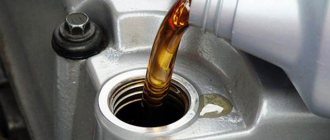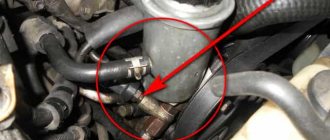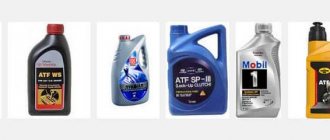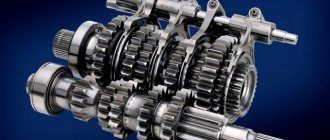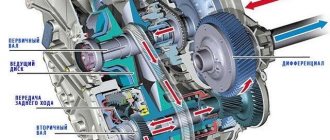Any unit that has rotating and rubbing parts needs lubrication. The gearbox is no exception. Lubricants have a certain service life. However, some car manufacturers declare so-called “eternal” gearboxes that do not provide for updating consumables.
That is, changing the oil in the gearbox is not expected at all. Can a car operate properly if the gearbox lubricant is not changed during its entire service life? Let's try to understand this issue not from the point of view of marketing statements, but from the technical side.
Why do you need to change the oil?
Any lubricant consists of several components.
- basis, or basic composition. It can be of natural origin (mineral base), or created artificially (synthesized from other chemical elements). To maintain a balance between performance properties and cost, lubricants can be compound (semi-synthetic: produced by mixing natural and synthetic raw materials);
- various additives that give the oil certain properties: antioxidant, detergent, etc.
Mineral raw materials are quite cheap, but are subject to aging, especially when exposed to high temperatures. It is for this reason that you should still periodically change the oil in the gearbox.
Synthetics are more resistant to external influences, but there are problems here too. Over time, the chemical bonds between the base and additives are lost, and the lubricant separates. In addition, the antioxidant components are not restored, and after a certain time they completely lose their properties.
As metal parts wear out, the gearbox becomes filled with small shavings and sawdust. Some of them settle on the built-in magnet, while the rest of the debris remains suspended in the oil. Changing the oil in the box allows you to clean the unit from wear products.
If we talk about the service life of transmission oil, supposedly equal to the service life of the car, then these figures cannot be unambiguous. Wear of oil components is determined by both mileage and operating time.
One car can cover one and a half million kilometers in 10 years (for example, a postal courier or a truck driver), while for another, this figure will not exceed 150 thousand.
In addition, the service life of transmission oils is affected by operating conditions. Prolonged exposure to ultra-low temperatures (below – 20°C) may cause the liquid to separate into the base and additives.
Back mixing when operating temperature is reached does not occur fully. The result is a kind of emulsion, the parameters of which deteriorate in comparison with whole oil.
If the car is operated in severe off-road conditions: liquid mud, fording, water can enter the gearbox cavity through the breather holes. The oil becomes unusable.
What's the result?
The period for replacing gearbox lubricant depends on several factors, conditions and features:
- the type of gearbox itself;
- mileage and technical condition of the car;
- intensity of operation of the unit;
Finally, we note that untimely replacement of the lubricating fluid in the gearbox leads to a decrease in its quality and, accordingly, to rapid wear of rubbing and loaded parts. When shifting gears, extraneous sounds may appear (grinding, humming or other noises, difficulty switching gears, etc.).
Is there a difference in gearbox types in terms of oil use and change?
An automatic transmission uses oil not only for its intended purpose (lubrication). Transmission fluid works in hydraulic elements: valves, shift mechanisms.
In addition, if the automatic transmission has a torque converter, ATF is used in the clutches. Accordingly, its performance characteristics (including wear resistance) are higher.
The transmission mixture in the automatic transmission is forcibly cooled (there is a radiator) and passes through the oil filter. Nevertheless, car manufacturers strictly regulate the service life. If you do not change the oil in the box in time, the entire unit may fail.
Changing the oil in a manual transmission is even more necessary because there is no protection for it (no filter or radiator). When a high temperature is reached (stressful driving in hot weather), the oil in the manual transmission foams and ceases to perform its main task - reducing friction. Moreover, foaming occurs precisely in old liquid, with a long service life.
About the role of gear oil
The operating conditions of the lubricating fluid in the engine and gearbox are very different. In the first case, it must penetrate into numerous small channels and minimize the sliding friction force that occurs when different surfaces come into contact. In a manual transmission, where torque is transmitted from the primary shaft to the secondary through gears with helical teeth, the friction force acts differently.
We recommend: Car cooling system: purpose, types, description, photo, device
Oil change intervals
If updating consumables is specified in the routine maintenance instructions, you just need to follow the manufacturer’s recommendations. It should be remembered that all service intervals are designed for normal operation:
- uniform movement on smooth roads;
- exclusion of incorrectly selected gear;
- no overload;
- Sudden starts from traffic lights are not allowed.
Is your riding style different from the ones listed? Feel free to reduce the time between replacements by 25% - 40%. If replacing the transmission fluid is not provided (or there is no data: for example, the regulation book is lost), the typical period for mechanics is 7 years or 100 thousand mileage (whichever comes first). Even on a weekend car, the gearbox lubricant loses its properties over time.
Intelligible about the timing of changing transmission oil in a manual transmission - video
The type of gearbox oil to be filled can be found in the same instructions, or on the car manufacturer’s website. You can turn to the dealer service for help, but they will most likely simply offer to carry out servicing (of course, for a fee). And after the end of the warranty period, most car owners have a desire to save on maintenance (in other words, to get out from under the financial bondage of the dealer).
There are other reasons for replacement:
- The fluid is dark or there is a lot of debris in it (check with a dipstick).
- The box is too loud (whistles, howls).
- It's hard to shift into gear.
The design and principle of operation of a manual transmission
The task of any transmission is to change the gear ratio of the force transmitted from the engine clutch to the differential of the driving wheels of the car. The internal combustion engine (ICE) is designed in such a way that it cannot change the speed of the crankshaft over a wide range. At the same time, the speed of the car should change smoothly from 0 to 180 km/h or more. This opportunity is provided by manual transmission speed switching.
Mechanical boxes come in 2- and 3-shaft designs. The input shaft is connected to the clutch, which transmits force from the internal combustion engine. It is connected through a gear to an intermediate shaft, on which gears with different numbers of teeth are rigidly strung, the so-called gears of the gears - first, second, third, etc. At a certain moment, one of them transmits force to the secondary shaft gear.
The secondary shaft is similar to the intermediate shaft, except for one important difference - the gears on it are movable. In addition to the fact that they can move along the axis of the shaft, they also rotate on it thanks to bearings. There is also the option of fixed gears along the axis of the secondary shaft. They are located strictly opposite the intermediate gears and rotate with them.
In neutral gear, all the gears of the secondary shaft rotate, but it is motionless, the car is stationary. When the gear is engaged by the gearshift lever, the secondary shaft begins to rotate. How does this happen? The shift forks, from the lever, actuate clutches that are rigidly fixed to the secondary shaft, but capable of moving along it. One of the couplings moves towards the gear and is rigidly connected to it with a toothed ring at the end. Thus, force is transmitted to the secondary shaft with a certain gear ratio. All gears have their own gears, the ratio of teeth creates the necessary gear ratios. Based on the design of the manual transmission, it becomes clear that it cannot work without a lubricant.
Changing the oil in a manual transmission
Changing the oil in a manual transmission is not much different from a similar procedure in an engine or automatic transmission. Difficulty can only arise when using so-called “maintenance-free” boxes, which may not have a drain plug in an accessible location.
When to change the oil in a manual transmission - video
For regular boxes, the algorithm is as follows:
- The oil is changed to “hot”, that is, the engine and gearbox must be warmed up. Preferably not at idle, but while driving. You shouldn’t get carried away, just drive 5-10 km.
- The machine is installed on an inspection pit or overpass. It is not possible to change the oil in the gearbox from under the hood.
- We free up the working space: remove the protection (if any), release the clamps and move the hoses and electrical wiring harnesses to the sides.
- If there is a dipstick (level indicator) in the box, take it out: depressurization will help the lubricant flow out faster.
- Open the level control plug (usually located in an easily accessible place).
- Place a container under the box housing and unscrew the drain plug.
The transmission mixture flows out of the box for quite a long time, you will have to wait at least 1 hour.
- You can remove the pan (if the design allows), check the condition of the gasket, and clean the cavities from wear products. Draining the oil will be much faster.
- Then we put everything back together and tighten the drain plug.
A crucial point: where to fill the transmission oil?
Your box almost certainly does not have a filler neck. There are three ways to fill a manual transmission with oil, depending on the design:
- through the dipstick tube, using a funnel or hose;
- through the level control hole;
- through the mounting point of some sensor (on the top cover).
It is more convenient to fill transmission oil using a syringe or other supercharger. You can simply squeeze a PET bottle: the main thing is to fit the hose hermetically.
Don’t forget to tighten all the plugs, sensors, and reinstall the dipstick.
When the mixture reaches the required level, it is necessary to perform a test drive of 5-10 km, alternating all gears. Then place the car on a flat surface, turn off the engine, and check the level after 10-15 minutes. Add oil if necessary.
Important: Overfilling above the control level is no less harmful than underfilling. After 100-200 km, check the level and condition of the transmission fluid.
Conditions that require mixture replacement
For example, if your transfer system, differential, or transmission is drowning in water or another foreign mixture, the transmission oil should be replaced. Contaminated oil can cause serious damage to the manual transmission, transfer case, or differentials if not properly lubricated.
You should also change your oil if your transfer system or differentials have recently had a leak repaired. Leakage may indicate contamination or poor quality of the mixture.
Important: Most mechanics will replace your transmission oil after repairing a leaking system component (this could be the crankcase), but this is often forgotten in garage DIY repairs.
Finally, if you or your mechanic discovers dirty transmission oil during an inspection, it should definitely be changed. Old or dirty oil causes destabilized viscosity and poor engine lubrication, which will prematurely wear out your transmission, transfer case and differentials.


